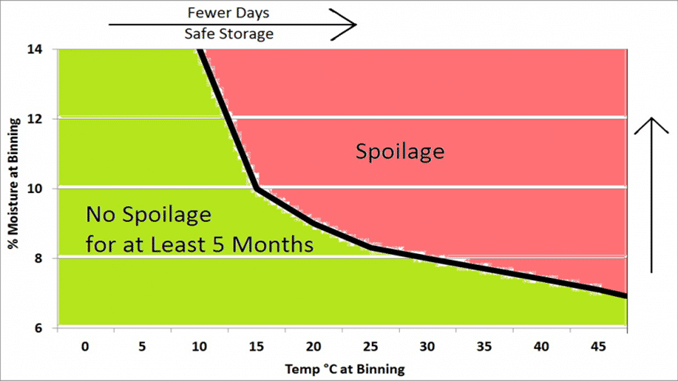What is the single most important priority at harvest?
Harvest is one of the busiest and often most stressful times of the year, which unfortunately means it is also the most dangerous. Keeping oneself and others safe must always take priority over getting the crop into the bin. Don’t cut corners, skip safety protocols or make unsafe ‘just this once’ decisions. Farm safety resources are available from the Canadian Agricultural Safety Association.
What are this week’s biggest storage risks?
- Daytime temperatures greater than 30°C mean canola will go into storage hot. Hot canola should be aerated to cool it even if it is binned at low moisture, as air currents within a hot bin will concentrate moisture, leading to heating and spoilage. To cool hot, moist canola, run fans constantly. To cool hot, dry canola, run fans when the air temperature is near the canola’s temperature or cooler; turn fans off if the ambient temperature is greater than 5°C warmer than the canola. (Harvesting at 30C – cool that canola)
- Weed seeds (especially kochia) generally contain more moisture than canola seeds. If weed seeds congregate in pockets in the bin, they can create hot spots where spoilage begins. Mowing out or otherwise managing kochia patches separately from the crop will result in less weed seed spoilage risk than combining through them.
- Green seed from reflowering canola and/or variably mature fields increases storage risk even in cool and dry canola. Small, shriveled canola seed, which is typical with high green seed, packs more tightly in bins and reduces air flow through the bin. Increase aeration to manage higher green seed. (Check more than just temperature for safe canola storage)

How to tackle reflowering canola post rain?
Rain in some regions means canola is regrowing, flowering and – in some cases – podding between swaths. Spraying out immature canola is typically the recommended option, which should improve harvestability and limit green seed. In cases where glyphosate alone, depending on preferred harvest timing, requires too many days for dry-down, consider adding Heat. Frost is another effective option. Keep in mind that a reflowering field will use nutrients in the soil. A soil test is always recommended.
When to best manage weeds post-harvest?
Fall spraying is an effective time to manage perennials and winter annual weed species, as managing these before winter can help preserve critical soil moisture for the following spring. Controlling winter annuals when they are small also offers better control. That said, spraying immediately after harvest will not offer the best results. Perennials that are chopped to stubble height at harvest require four to six weeks to regrow sufficient leaf tissue to absorb the herbicide, and typically require 2-3x the glyphosate concentration for effective control. (What is the best time for fall weed control) (Fall weed control and frost)
How to assess maturity in uneven fields?
Uneven emergence and challenging growing conditions mean plant growth staging may be variable within a field. Maximizing profitability, yield and on-farm efficiency depends on accurately rating maturity and determining when to begin harvest. Refer to the Canola Council of Canada’s Canola Swathing Guide for tips on how to assess an uneven field. (What to do with uneven fields) (Harvest management – timing, quality and yield)
